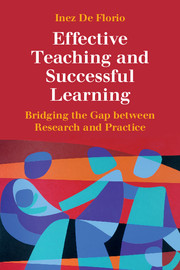Book contents
- Frontmatter
- Epigraph
- Contents
- Preface
- Introduction
- 1 Main Features of Scientific Research on Education
- 2 Important Types of Scientific Research on Education
- 3 Main Features of Evidence-based Research on Education
- 4 Meta-Analyses on Education
- 5 A Synthesis of Over 800 Meta-Analyses Relating to Achievement
- 6 Scaffolding Effective Teaching and Successful Learning
- 7 Planning and Starting the Lesson
- 8 Presenting Knowledge and Skills – Assertive Questioning
- 9 Guided and Independent Practice
- 10 Cooperative and Project-based Learning
- 11 Feedback – Reciprocal and Informative
- Concluding Remarks: Standards Need More Evidence
- References
- Index
9 - Guided and Independent Practice
Published online by Cambridge University Press: 05 June 2016
- Frontmatter
- Epigraph
- Contents
- Preface
- Introduction
- 1 Main Features of Scientific Research on Education
- 2 Important Types of Scientific Research on Education
- 3 Main Features of Evidence-based Research on Education
- 4 Meta-Analyses on Education
- 5 A Synthesis of Over 800 Meta-Analyses Relating to Achievement
- 6 Scaffolding Effective Teaching and Successful Learning
- 7 Planning and Starting the Lesson
- 8 Presenting Knowledge and Skills – Assertive Questioning
- 9 Guided and Independent Practice
- 10 Cooperative and Project-based Learning
- 11 Feedback – Reciprocal and Informative
- Concluding Remarks: Standards Need More Evidence
- References
- Index
Summary
After the presentation phase, knowledge, skills, and attitudes are, at most, stored in short-term/working memory. In other words: fragments of the new learning content – hopefully the most relevant – have reached the students’ minds. They will fade if presentation, modeling, or demonstration is not followed as soon as possible by practice.
Before we deal with the next steps of the Model of Effective Teaching (MET) that regard guided and independent practice, a summary of the preceding phases of planning and starting the lesson, as well as presenting the new learning content, is given in order to better relate the following types of practice to the goals, standards, and objectives of the lesson or the teaching unit.
Practice of presented knowledge and skills – also called the “apply” phase – does not only relate to different aspects of the targeted goals. There are various types of practice, such as exercises, tasks, and more encompassing learning activities with regard to the involvement of the teacher and, most importantly, of the learners. The differentiation between guided and independent practice is only a rough distinction which comprises much overlapping. Therefore, it is crucial to know what form of practice and which task types to choose for different learning intentions.
Guided and independent practice, as with all steps of the MET, have to be thoroughly planned on the basis of students’ needs and interests. Some examples will show what has to be taken into account in order to reach as many students as possible and to help them pass from surface to deeper and conceptual learning.
SUMMARY OF THE PRECEDING STEPS OF THE MET
During the orientation phase, which means the beginning of the lesson, the teacher has informed the students about the goals, the learning intentions, and the success criteria (Hattie, 2009, pp. 163–167, challenging goals d = 0.56, rank 34). This orientation happens best in an interactive dialogue. As early as the start of the lesson, the students may be asking questions about what, why, and how. As it can be a long process to encourage them to enter in this form of dialogue with the teacher and their peers, every student question should be welcomed and answered (Hattie, 2009, pp. 182–183, questioning d = 0.46, rank 53).
- Type
- Chapter
- Information
- Effective Teaching and Successful LearningBridging the Gap between Research and Practice, pp. 157 - 174Publisher: Cambridge University PressPrint publication year: 2016



